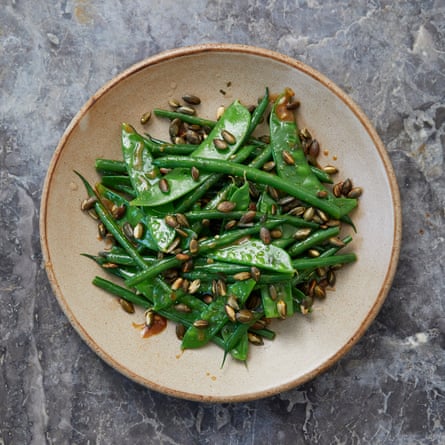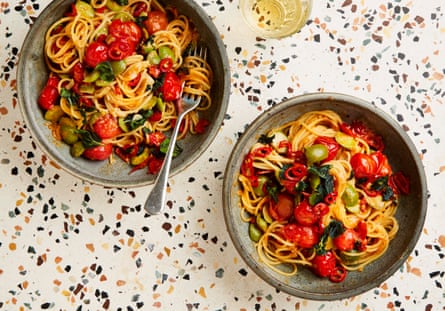
Miso is a flavourful paste made from fermented soybeans. Rice or kome miso, the most popular type, is made with soybeans, water, salt and rice inoculated with a culture called koji. In barley or mugi miso, the rice koji is replaced by barley koji. But the most obvious difference between misos is in their appearance: they can be straw-pale or near-black, smooth or chunky. As a rule, the paler the miso, the sweeter and lighter it will be. Some leading authorities on miso maintain that the complexity of its flavour makes it hard for westerners to describe, but I’d beg to differ. It’s hard to describe the taste of a courgette, but miso is so flavourful that it’s hard to stop describing it – you might detect barnyard, nutty, brown butter, caramelised, exotic fruit (banana, mango, pineapple), olive, briny, boozy or chestnut blossom notes. It is especially good with rustic flavours such as alliums, root vegetables and seaweed, but it has some less likely partners, too.
Carrot
The food writers John and Jan Belleme advise that sweet white miso can be used where you might otherwise use dairy, say in mashed potato, added to tofu to make a cream cheese-style dip, or stirred into a soup. No one would mistake carrot and miso soup for cream of carrot, but the miso does have a pleasingly enriching effect.
Chives
Scatter a loose mosaic of chopped chives over a red miso soup and wait a few minutes before drinking – it tastes like onion soup laced with sherry.
Chocolate
The miso brownie was probably conceived in about 2014, and recipes generally call for a small amount of sweet white miso, which will barely scrape your salted chocolate receptors. Red miso, meanwhile, will deliver a pronounced fermented tang, which is both pleasing in its own right and authentically brownie-like, because chocolate has many of the same flavour notes. Mixed in a ganache, miso and dark chocolate make for an extreme combination of sweet, salt and bitter. I like to spread it on a digestive biscuit, with its own roasted, malty flavours and a hint of salt; the crumbly texture of the biscuit also nicely offsets the smooth ganache. Miso chocolate digestives are going to make my fortune.
Corn
Mix miso with butter, oil or mayonnaise to spread on a corn cob. The cereal-vegetal, fermented funk of miso hits first, before the sweetness reveals itself, with the salt teasing out the corn flavours that might otherwise be sweetened into undetectability. Or try miso ramen with a brood of bright kernels nesting on the noodles. The experience is no less enjoyable for being less intense.
Egg

Misozuke are foods pickled in miso, and are usually served as a snack or an accompaniment to a meal. Carrots, radishes, kabocha squash and cauliflower are all popular. The technique is also used for meat and fish, but my favourite misozuke are boiled eggs, which taste a bit like they’ve been pickled in gravy. In comparison, the dear old English chip-shop pickled egg is shown as the bald, vinegary thug it really is. Boil four eggs for six to seven minutes, then let them cool before peeling them. Loosen 200g miso with 50ml mirin and sweeten it with a tablespoon of sugar – you’re aiming for a consistency soft enough to coat the egg easily, so if it seems too thick, add a little water or sake. Pour the mixture into a freezer bag, followed by the eggs. Leave in the fridge for half a day to two days, gently palpating the bag now and then. Tell your loved ones that this is to ensure the eggs are properly covered, although you and I know it’s just because it feels nice.
Green beans

Miso lends a salty meatiness. For two to four servings, simmer 250g green beans until al dente, then refresh in cold water. Mix two teaspoons of red miso into two tablespoons of softened butter. Put two teaspoons of vegetable oil in a frying pan on a medium-high heat, add the beans and warm them through for a few minutes. Add two tablespoons of finely chopped shallot and a crushed garlic clove, and cook for another minute. Add four tablespoons of sake, simmer until reduced by half, then pour in four tablespoons of water and simmer until reduced by half again. Add the miso butter and warm gently until it has melted and coated the beans.
Honey
Used as a dressing or a condiment, neri miso is a combination of miso, honey (or sugar) and water (or sake) that has been simmered for a short spell. Its extremes of salt and sweet are so balanced, it’s as if your tastebuds have been put into a painful, yet deeply soothing, yoga position. To make a basic version, simmer five tablespoons of red or white miso, two tablespoons of honey and two tablespoons of sake or water in a small pan for two minutes, stirring until it’s thick but still pourable; you might also like to add two tablespoons of mirin. Make a batch and experiment with popular additions such as nuts, seeds, vegetables and seafood; peanuts and sesame are a much-loved combination in Japan.
Pecan nuts
Buttery is the most common flavour note for pecans, though it reveals itself late in the chewing. Some pecans, however, have more of a plant-dairy quality, like warm, slightly sweetened soy milk, which makes miso a natural pairing. The combination of sweet white miso and pecan is cake-like, whereas red miso and pecan recalls stone fruit. The miso maker Bonnie Chung pairs red miso and pecan with maple syrup and rice vinegar to make a condiment for udon noodles and greens cooked in dashi or vegetable stock.
Tomato

Miso has the boldness and richness of balsamic vinegar, says the chef Tim Anderson and, like balsamic, its pronounced sweet-sourness can redeem average tomatoes. And let’s face it, on average, tomatoes are average. Dissolve a heaped tablespoon of red miso in two tablespoons of rice vinegar with a pinch of salt, then stir in three tablespoons of rapeseed oil. Slice the tomatoes, toss them in the dressing and leave for a good few hours to soak it up.
Yoghurt

“Miso-tahini is a vegetarian classic,” writes fermentation expert Sandor Katz, “but miso-peanut butter and miso-yoghurt combinations are just as delicious.” Fattiness is the key, he explains, because it acts as the carrier for miso’s “dense, salty flavour”. Katz stipulates four parts fatty ingredient to one part miso, with a bit of sourness added for balance – use kimchi or sauerkraut liquor. Even if you don’t like them, you can at least bore on for hours about your gut bacteria.
This is an edited extract from The Flavour Thesaurus: More Flavours, by Niki Segnit, published this week by Bloomsbury at 20. To order a copy for £17.60, go to the Guardian bookshop
Additional photography: Ola O Smit, Louise Hagger, Getty Images/Johner. Food stylists: Ellie Mulligan, Emily Kydd. Prop stylist: Jennifer Kay. Louie Waller. Food styling assistants: Susanna Unsworth, Emmy Fyles, Katy Gilhooly.



